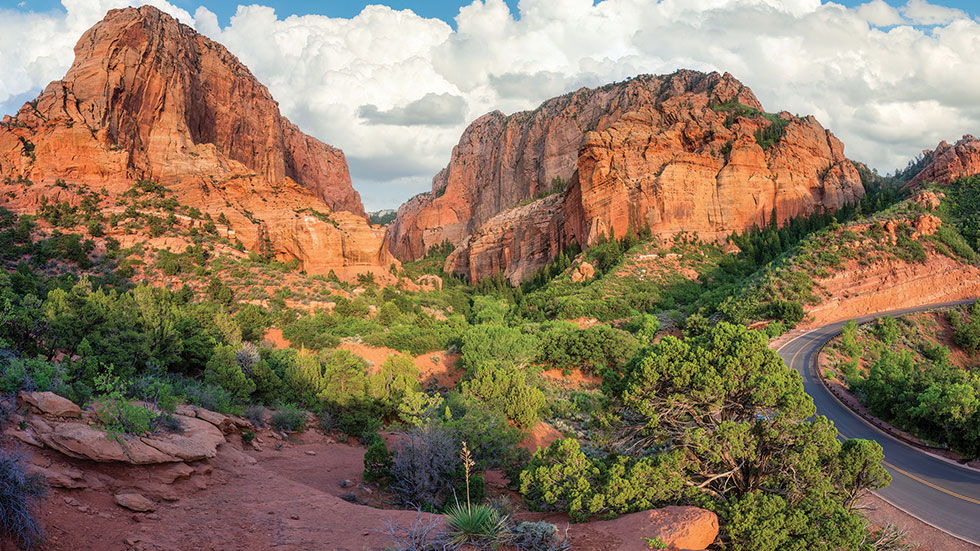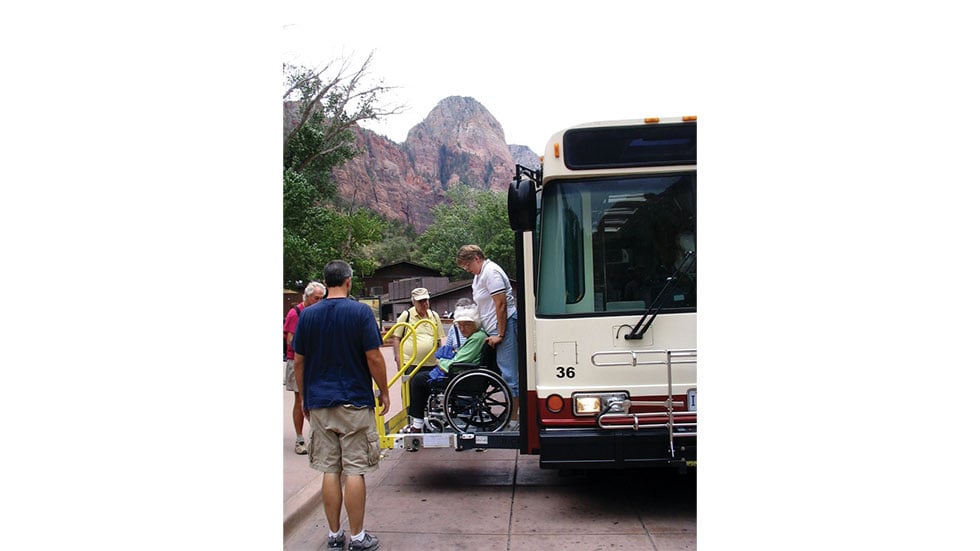4 US National Parks Accessible to Those with Disabilities
Travelers with disabilities may find these US National Parks to be ideal destinations

ZionNationalPark, Utah. Photo by lucky-photo/Stock.Adobe.com
One afternoon two-and-a-half years ago, my husband, Todd, stepped onto a low roof of our house in an attempt to clean off leaves. He immediately slipped and fell, twisting his feet in the ladder rungs and landing on his neck. Todd suffered a spinal cord injury that left him an incomplete quadriplegic.
In an instant, our lifestyle of adventuring and traveling was reduced to a sad fraction of what it once was. After decades of long-distance backpacking and cycling, we were suddenly thrust into the club of the disabled, and we didn’t know quite how to navigate it.
The centers for disease control estimates that one in four American adults—about 61 million people—lives with a disability, whether visible or invisible, which may keep them at home. But a life indoors, surrounded by screens and technology, robs you of the beauty and wonder of the natural world. Todd and i know that travel expands your mind and gives you a new perspective on life. So, although we had to accept his accident, we also knew we had to find ways to get back outdoors and moving.

View of Mather Point from the Rim Trail along the Grand Canyon’s South Rim. Photo by Craig Zerbe/Stock.Adobe.com
After intensive physical therapy, Todd can now slowly walk short distances and wheel longer trails in natural areas near our Pennsylvania home. But we want to get back to traveling.
We have always loved our national parks; in fact, we had visited most of them as we were raising our children. Now, in an attempt to bring more joy and beauty, as well as health and healing, into our shattered lives, we want to begin visiting the parks again.
What we’ve discovered in our research is that the us national park service leads the way in making its facilities more accessible to those with disabilities, from providing shuttle buses and free admission passes, to offering ADA-compliant restaurants and accommodations, to creating informative websites and apps.
 A road winds through the Kolob Canyons district of Zion National Park. Photo by Craig Zerbe/stock.adobe.com
A road winds through the Kolob Canyons district of Zion National Park. Photo by Craig Zerbe/stock.adobe.com
GAINING ACCESS
A person with a permanent disability can request a free lifetime access pass that allows them to visit the 2,000 us recreation sites (including the national parks) managed by six federal agencies. The pass includes admission as well for three persons traveling in the same vehicle with the traveler who has a disability. There are additional discounts for camping, swimming, boat launches and more.
Some national parks are more accessible than others, of course, and some are downright wheelchair friendly. The Grand Canyon, Yosemite, Yellowstone and Zion are not only among the biggest, most spectacular national parks, but they also score high in accessibility.
Each of the parks detailed here has driving routes with great windshield views as well as short accessible trails to overlooks. All have accommodations that are completely accessible, including some rooms with wheel-in showers as well as accessible restaurants and other services. Wheelchairs can be rented or loaned free.
Visitor centers have the latest accessible trail conditions, maps and information. The Grand Canyon, Yosemite and Zion have free park shuttles with lifts for wheelchairs. Yellowstone is so vast, however, that you’ll need to get around in your own vehicle.
These four parks (and many others) are awe-inspiring, capable of moving your soul when you gaze upon their stunning beauty. And a mobility issue does not have to keep you from that experience.

Shuttles at the Grand Canyon’s South Rim are wheelchair accessible. Photo courtesy of NPS
GRAND CANYON NATIONAL PARK
More than 6,000 feet deep and up to 18 miles across, the Grand Canyon is one of the seven natural wonders of the world. Its layered bands of colorful rock reveal millions of years of geologic history, flooding you with a feeling of the immensity of time.
The south rim offers plenty to do, boasting more than a dozen wheelchair-friendly trails, including large sections of the rim trail, which runs alongside the canyon. There’s also the accessible 1.3-mile trail of time, where you can touch samples of Grand Canyon rocks, and the hermit road section of the greenway trail, which stretches 2.8 miles long with six overlooks. In addition to using the free shuttle bus, if you have a disabled parking placard you can request a scenic drive accessible permit to drive on restricted roads that are closed to public traffic and are virtually empty.

Wheelchair-accessible viewing spots allow most anyone to see Yellowstone’s famed Old Faithful. Photo courtesy of NPS/Jim Peaco
YELLOWSTONE NATIONAL PARK
America’s (and the world’s) first national park, Yellowstone is where conservation began, thanks to President Theodore Roosevelt’s visit and his love of the landscape. The geothermal features of spouting geysers, boiling mud pots, steaming hot springs, tumbling waterfalls and crazy-bright colors in the soil and sulfur pools are enough reason to visit. Add in the diversity and sheer numbers of wildlife—including bison, wolves, elk and mule deer—that populate the 2.2-million-acre park, and it’s no wonder that Yellowstone has earned the title the “American Serengeti.”
Yellowstone has eight major areas, with accessible sights in every one of them. Some great wheelchair-accessible boardwalks take the wheeler safely through the park’s best geological areas. The park also offers wheelchairs with giant inflatable tires that enable you to access the beach along the shoreline of Yellowstone Lake.

A level, paved trail makes Yosemite Falls more accessible to those with disabilities. Photo courtesy of NPS/James Miller
YOSEMITE NATIONAL PARK
Among the standout features of this park is the massive white granite canyon with iconic landforms like El Capitan and half dome towering above the glacial-carved valley. Then there are the giant sequoia trees, the largest tree species in the world, in the mariposa grove. Their height soars more than 300 feet, and their massive girth can reach 30 feet wide at ground level.
The waterfalls are some of the highest in the world, cascading off sheer rock walls. A three-quarter-mile paved and level trail leads to gorgeous Yosemite falls; above the valley, paved trails lead to glacier point and Washburn point, among others.
 Wheelchair users can be accommodated by the shuttles at Zion. Photo courtesy of NPS
Wheelchair users can be accommodated by the shuttles at Zion. Photo courtesy of NPS
ZION NATIONAL PARK
Red, pink and white Navajo sandstone cliffs and deep canyons as well as unusual rock formations produce a cathedral of nature in Zion. There are slot canyons, emerald pools and gushing waterfalls.
The wheelchair-accessible 1.8-mile Pa’rus trail along the virgin river winds through the heart of the widest part of Zion canyon. Here, you’re dwarfed by 1,000-foot sheer vertical walls of Navajo sandstone that have been sculpted into some of the most beautiful forms in the desert southwest. The big bend shuttle stop brings you to some of Zion’s most famous features, including angels landing and the great white throne.
The life of a person with a disability can feel small and limited, besides enormously challenging and difficult. For Todd and me, spending time in the natural world has filled our lives with much joy and a feeling of great peace. Experiencing awe can bring about a transcendent state in which you focus less on yourself, your discomfort and hardship and feel more connected to a larger whole. It’s a sensation we can all appreciate but especially so for a person with a disability who can feel locked in an immobile body. Todd and i are excited to return to our national parks—and to know that these awe-inspiring places are there for all of us, including those with disabilities.
Other Highly Accessible National Parks include Acadia, Badlands, Carlsbad, Congaree, Death Valley, Everglades, Glacier, Great Sand Dunes, Great Smoky Mountains, Grand Teton, Mammoth Cave, Rocky Mountain, Saguaro, Sequoia and Shenandoah National Parks along with Sleeping Bear Dunes National Lakeshore.
